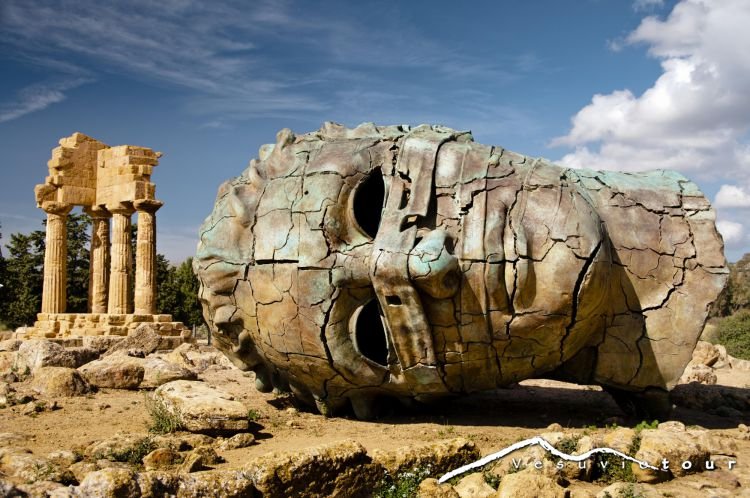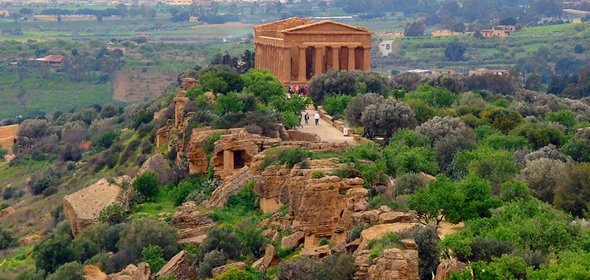
History of the Valley of the Temples
Akragas (or Ackragas) was founded in 580 BC by Greek colonists from nearby Gela (Sicily), who had come from Rhodes a hundred years earlier. After a period of tyranny, Akragas flourished as a democracy known for its high-quality wine, olives and horses. It had a population of about 200,000 in the 5th century BC, when most of its famous temples were constructed.
In 406 BC, Akragas was beseiged for eight months and eventually defeated by the Carthaginians, who razed the city and purposefully burned and mutilated the temples. The city was patched up after Timoleon defeated Carthage in 340 BC, but it would never regain its original glory. The Romans took Akragas in 210 BC and it remained a Roman city called Agrigentum until the fall of the empire.
The city fell to the Arabs in 827 AD and the Normans in 1087. Modern Agrigento has suffered from the decline of the sulpher industry but is now recovering thanks to tourism and the export of the quality produce that still grows in its fertile soil: almonds, wine, oranges, olive oil and vegetables. The "Archaeological Area of Agrigento" became a World Heritage Site in 1997.
What to See at the Valley of the Temples
Much of ancient Akragas still remains to be excavated, but what has been uncovered so far is extensive. The area known as the Valley of the Temples is located south of the modern town on a lower ridge (not technically in a valley).
The most famous temple of Agrigento is the Temple of Concord (Temple F to archaeologists), one of the best-preserved Doric temples in the world. Mostly spared by the Carthaginians and later converted into a church, it is almost entirely intact - only its roof is missing.
St. Gregory, Bishop of Agrigento, converted the temple into a church in the 6th century after "chasing away the demons who were there, hiding in the idol." The church was mostly stripped away in the restoration of 1788 mentioned in a facade inscription, but the nave arches can still be seen in the walls of the cella.
Dated to c.450-440 BC based on its style, the Temple of Concord has an area of 125 x 55 feet at the level of the top step. It has a peripteral hexastyle plan, with 13 columns along each side and 8 columns on each end. The Doric columns are 22 feet high including the capitals and have a diameter of 4.5 feet at the base.
The dedication of the temple is unknown; "Temple of Concord" seems to have no historical basis. Nevertheless, local tradition says that newlyweds who visit the temple on their wedding day will have a peaceful marriage.
The deity honored by the so-called Temple of Hercules (or Heracles; a.k.a. Temple A) is not known; there is no evidence to support its traditional name. It has an early date of about 500 BC and once enjoyed a prominent position next to the main city gate. Today only some of the south colonnade stands, re-erected in 1924.
The Temple of Hercules was the second-largest temple at Agrigento, measuring 220 x 83 feet at the top step. Its outer colonnade has 6 by 15 columns. The temple has an innovative plan for Sicily: a back porch as well as a front porch; and stone staircases flanking the interior shrine doorway.
In antiquity the temple was famous for its statue of Hercules, which the notorious art thief Caius Verres attempted to steal for his governor's palace around 73 BC. Plans of the raid were leaked, and the Roman soldiers were overpowered by the local citizens. The temple was also reported to contain a magnificent painting of the infant Hercules strangling a serpent, painted by the famed artist Zeuxis.
The Temple of Heracles was damaged by fire sometime in antiquity and later renovated by the Romans, who added three small cult-rooms at the back of the shrine. A large statue of Asklepios was discovered in one of these rooms.
It may not seem like it now, but the Temple of Olympian Zeus (Tempio di Giove Olimpico) was the chief temple of Agrigento, built near the agora and the southern city wall. It was also one of the most famous temples of ancient Sicily. Local historian Diodorus boasted in 40 BC: "As it is the largest temple in Sicily, it may not unreasonably be compared, so far as the magnitude of its substructure is concerned, with the temples outside Sicily."
The Temple of Zeus was begun in the late 6th century and still incomplete when the Carthaginians invaded in 406 BC. It has since entirely collapsed. The great Doric temple was a massive 361 x 173 feet in area.
Instead of the usual colonnade, it was surrounded by a solid wall decorated with 7 by 14 half-columns, with huge Atlas figures between the columns. The Atlases, positioned so they appeared to be supporting the temple, were added in c.480-50 BC and stand 25 feet high. A fallen example can be seen near the temple.
Inside the temple, two parallel rows of square piers are joined by a solid wall to create three aisles. Roof tiles have been found, but it is possible the central aisle was left open to the sky.
The Temple of Juno (a.k.a. Temple of Hera Lacinia; Temple D) occupies a particularly high position on the ridge at the southeast corner of the ancient city. It is further elevated by the use of four steps instead of the usual three on the temple platform.
Dated to 460-50 BC based on its style, the Temple of Juno retains most of its original colonnade, which has been partially restored. It measures 125 x 55 feet at the top step and has 6 by 13 columns. Stone staircases flank the doors of the inner shrine. Traces of the burning by the Carthaginians are still visible.
At the west end of the temple ridge is the Temple of the Dioscuri (Tempio di Castore e Polluce; Temple I), dating from 450-400 BC. Its northwest corner was beautifully reconstructed in 1836-71, but not authentically: it consists mainly of modern masonry aged for artistic effect. The temple was Doric, with 6 x 13 columns. As with most of the other temples, the name is only traditional and the original dedication is unknown.
Just south of the Dioscuri ruins are scattered column drums from Temple L, dating from c.470 BC. Inside the southwest corner of the city wall are the scant remains of the Temple of Vulcan or Hephaistos (Temple G), begun c.430-25 BC. Only two unfinished columns can be seen today.
Temple E is located in the modern city and has been converted to the church of Santa Maria dei Greci (St. Mary of the Greeks). Dating from c.500-450 BC, this was a Doric colonnaded temple with 6 columns on the ends and an unknown number on the sides. The temple columns can be seen embedded in the interior walls of the church, and part of the temple platform survives outside.

